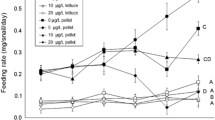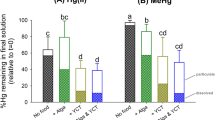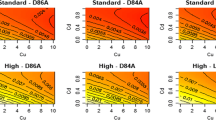Abstract
The effects of diet, water hardness, and population source on acute toxicity, and diet and water hardness on chronic toxicity of copper (Cu) toCeriodaphnia dubia were evaluated. A diet of three algae (Chlamydomonas rheinhardti, Ankistrodesmus falcatus, and Chlorella vulgaris, hereafter referred to as CAC) cultured in vitaminenriched media was superior to synthetic diets consisting of yeast, Cerophyll, and trout chow (YCT). Neonates from mothers reared on CAC were 1.4 to 1.5 times more resistant to Cu than those reared on YCT or yeast and Cerophyll (YC). Forty-eight hr LC50s of Cu toC. dubia increased from 35 to 79 μg/L at water hardness of 94 and 170 mg CaCO3/L. Three populations ofCeriodaphnia derived from three USEPA (United States Environmental Protection Agency) laboratories showed no differential Cu sensitivity. Chronic Cu impairment was measured by neonate production in the 7-day life-cycle test. Chronic values were 7.9 and 10.1 μg/L at water hardnesses of 94 and 170 mg/L respectively. A comparison of daily water renewal and renewal on days 3 and 5 only was made. Neonate production was significantly greater using day 3 and 5 renewals (Friedmann's Rank Sum Test, p < 0.005), even though Cu concentrations were comparable between the two tests. Therefore, handling stress may have been incurred using daily changes. It is recommended that future tests and USEPA guidelines should address deleting YCT and including multi-algal diets for culturing and chronic testing ofCeriodaphnia.
Similar content being viewed by others
References
Berner DB (1986) Taxonomy ofCeriodaphnia (Crustacea: Cladocera) in US Environmental Protection Agency cultures. US Environmental Protection Agency-600/4-86-032. Cincinnati, OH
Buikema AL (1970) Some effects of light on the biology of the cladoceranDaphnia pulex Leydig, emend. Richard, 1886. PhD Dissertation, University of Kansas, Lawrence, Kansas
Carlson AR, Nelson H, Hammermeister D (1986) Development and validation of site-specific water quality criteria for copper. Environ Toxicol Chem 5:997–1012
Cowgill UM, Williams D, Esquivel JB (1984) Effects of maternal nutrition on fat content and longevity of neonates ofDaphnia magna. J Crust Biol 4:173–190
Cowgill UM, Keating KI, Takahashi IT (1985a) Fecundity and longevity ofCeriodaphnia dubialaffinis in relation to diet at two different temperatures. J Crust Biol 5:420–429
Cowgill UM, Hopkins DL, Applegath SL, Takahashi IT, Brooks SD, Milazzo DP (1985b) Brood size and neonate weight ofDaphnia magna produced by nine diets. In:Bahner RC, Hansen DJ (eds) Aquatic Toxicology and Hazard Assessment: Eighth Symposium (ASTM STP 891). American Society for Testing and Materials, Philadelphia, PA, pp 233–244
Cowgill UM, Emmel HW, Takahashi IT (1985c) Inorganic chemical composition of trout food pellets and alfalfa used to sustainDaphnia magna Straus. Bull Environ Contam Toxicol 34:890–896
Czeczuga B, Bobiatynska-Ksok E (1972) The extent of consumption of the energy contained in the food suspension byCeriodaphnia reticulata (Jurine). In: Kajak Z, Hillbricht-Il- kowska, A (eds) Proceedings of the IBP-UNESCO Symposium on Productivity Problems in Freshwaters. Kazimierz, Dolny, Poland, pp 739–748
Daum RJ (1970) A revision of two computer programs for probit analysis. Bull Entomol Soc Am 16:10–15
DeGraeve GM, Cooney JD (1987) Letter to the Editor.Ceriodaphnia:An update on effluent toxicity testing and research needs. Environ Toxicol Chem 6:331–333
Elnawabary MT, Welter AN, Robideau, RR (1986) Relative sensitivity of three daphnid species to selected organic and inorganic chemicals. Environ Toxicol Chem 5:393–398
Hollander M, Wolfe DA (1973) Nonparametric Statistical Methods. John Wiley & Sons, New York
Horning WB, Weber CI (1985) Short-term methods for estimating chronic toxicity of effluents and receiving waters to freshwater organisms. US Environmental Protection Agency/600/4-85/014. Cincinnati, OH
Jones PA (1985) New York State manual for toxicity testing of industrial and municipal effluents. Division of Water, New York State Department of Environmental Conservation, Albany, NY
Knight JT, Waller WT (1987) IncorporatingDaphnia magna into the seven-dayCeriodaphnia effluent toxicity test method. Environ Toxicol Chem 6:635–645
Kobayashi M, Hoshi Y (1983) Haemoglobin inCeriodaphnia Comp Biochem Physiol 74A:919–922
Kobayashi M, Yoshida T (1986) Effect of hemoglobin concentration on swimming activity ofCeriodaphnia quadrangula in low oxygen concentrations. J Crust Biol 6:207–213
Mount DI, Norberg TJ (1984) A seven-day life-cycle cladoceran toxicity test. Environ Toxicol Chem 3:425–434
Norberg J, Mount DI (1985) Diets forCeriodaphnia reticulata life cycle tests In:Cardwell RC, Purdy R, Banner RC (eds) Aquatic Toxicology and Hazard Assessment Seventh Symposium (ASTM STP 854) American Society for Testing and Materials, Philadelphia, PA, pp 42–52
Peltier WH, Weber CI (1985) Methods for measuring the acute toxicity of effluents to freshwater and marine organisms. US Environmental Protection Agency/600/4-85/013. Cincinnati, OH
Smyly WJP, Collins VG (1975) The influence of microbial food sources and aeration on the growth ofCeriodaphnia quandrangula (O.F. Muller) (Crustacea:Cladocera) under experimental conditions. Freshwater Biol 5:521–526
Spehar RL, Fiandt JT (1986) Acute and chronic effects of water quality criteria-based metal mixtures on three aquatic species. Environ Toxicol Chem 5:917–931
United States Environmental Protection Agency (1983) Methods for chemical analysis of water and wastes. US Environmental Protection Agency/600/4-79-020, Cincinnati, OH
— (1985a) Technical support document for water qualitybased toxics control. US Environmental Protection Agency, Office of Water, Washington, DC
- (1985b) Ambient water quality criteria for copper- 1984. US Environmental Protection Agency-440/5-84-031, Washington, DC
— (1985c) Guidelines for deriving numerical national water quality criteria for the protection of aquatic organisms and their uses. PBS85-227049. National Technical Information Service, Springfield, VA
Valdes RA, Hartwell LA, Maxwell JR, Dell MM (1982) Metal bioconcentration factors with digestion procedures, Pharmacol Biochem Behav 16:915–917
Vanni MJ (1986) Fish predation and Zooplankton demography: Indirect effects. Ecology 67:337–354
Author information
Authors and Affiliations
Rights and permissions
About this article
Cite this article
Belanger, S.E., Farris, J.L. & Cherry, D.S. Effects of diet, water hardness, and population source on acute and chronic copper toxicity toCeriodaphnia dubia . Arch. Environ. Contam. Toxicol. 18, 601–611 (1989). https://doi.org/10.1007/BF01055028
Received:
Revised:
Issue Date:
DOI: https://doi.org/10.1007/BF01055028




